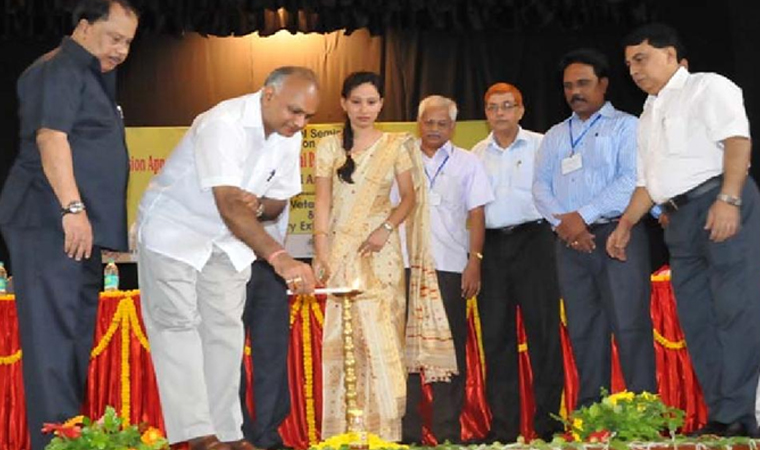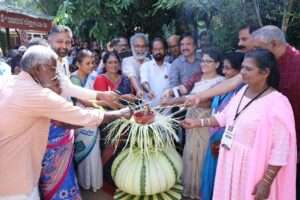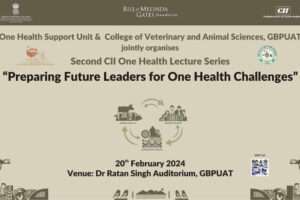 Prof S V N Rao, Head, Division of Veterinary and Animal Husbandry Extension at the Rajiv Gandhi Institute of Veterinary Education and Research (RIVER), Puducherry reflects on his participation in the Indian Veterinary Extension Forum (IVEF) seminar at Guwahati, India.
Prof S V N Rao, Head, Division of Veterinary and Animal Husbandry Extension at the Rajiv Gandhi Institute of Veterinary Education and Research (RIVER), Puducherry reflects on his participation in the Indian Veterinary Extension Forum (IVEF) seminar at Guwahati, India.
Rural communities in the NER generally depend on paddy cultivation, livestock and fisheries for their livelihoods. Almost all the people consume pork, fish and meat (goat meat and chicken) in descending order of preference. Their preference to milk and milk products is very low. However this preference varies widely across the different states. They rear local breeds of cattle, goats, pig, poultry, yak and mithun. Most of the livestock owners are adopting the traditional practices of rearing livestock mainly because of the poor delivery of livestock services. Yak and mithun are reared in free range system in high altitudes whereas pigs are reared in backyard system.
LESSONS LEARNT FROM PAST AND ON‐GOING LIVESTOCK APPROACHES
Livestock and fisheries extension can contribute significantly in exploiting the increasing demand for pork, meat and fish: Lot of scope exists for the development of piggery, poultry, goat and fisheries as the local demand and supply gap for pork, meat and fish is more than 50 %. Though several organizations exist in this region for the development of the local animal resources such as pig, yak, mithun, fishes, and small ruminants, the success achieved is not up to the expected level. This is attributed to low awareness of the livestock owners, low budgets and poor infrastructure facilities available for livestock extension and other situational factors like difficult terrain, flash floods, and torrential rains that obstruct the smooth delivery of livestock services. The livestock and fisheries extension has a vital role to play in improving the livestock and fish production in the area. The Hon’ble Vice Chancellor of Assam Agricultural University, Dr. K.M.Bujarbaruah in his presidential address made a fervent appeal for producing enough of quality seeds i.e. piglets, goat kids, chicks, fingerlings etc. to be supplied to the needy livestock owners to improve their livelihoods.
Delivery of information not enough : Dr. K. Sharma, as Project coordinator for Foot and Mouth Disease (FMD) in association with an NGO ( Assam Centre for Rural Development) presented his successful experience of controlling FMD in cattle and pigs in the selected villages. He believes that providing necessary information coupled with technical service and inputs only helps the livestock owners in adopting the practices. Inadequate livestock service is one of the main reasons for the poor livestock development in the area, he argued. It is a well recognized fact that to adopt livestock and fisheries technologies/ practices, farmers do need access to inputs. In the absence of inputs and technical services required for using the information, providing only information is meaningless. While inaugurating the seminar, the Chief Guest Sri.V.K. Pipersenia, Additional Chief Secretary and Agricultural Production Commissioner, Govt. of Assam, focused on the importance of providing timely and quality services to the livestock owners by the veterinarians. He puts the onus on the veterinary faculty to groom the budding veterinarians to develop the concepts of service and commitment to the society.
Scientists are in favour of ITK in livestock management: The livestock owners as well as fishermen still depend upon the indigenous technical knowledge (ITK) in rearing their livestock and fishes. They rear local breeds, follow traditional management and health care practices. They believe it is better for them to depend upon ITK as the scientific or modern methods require additional inputs and better quality services which are not accessible to them. Dr.R.K.Singh from NRC Mithun argued in favour of conserving local or desi poultry (chicken) as they have got unique advantages in terms of very high dressing percentage (90%), self sustaining ( no need to depend upon purchased chicks and hatcheries), thrive well in the local environment, better agility to survive from predator attacks , disease resistance etc (characteristics not found in improved backyard poultry varieties like vanaraja, giriraja, gramapriya, swarnadhara etc.). The backyard poultry keepers have their own time tested bamboo materials for feeding, laying eggs, night shelter etc. Similarly, Dr.K.K.Baruah, Retired Director, National Research Centre on Yak) based on his vast experience in yak management observed that “ITK is preferred in yak management”.
No crossbreeding in Mithun: Dr.Chandan Rajkhoa, Director, NRC Mithun expressed his idea of conserving mithun through natural selection and inbreeding rather than crossbreeding. Mithun is a highly valued animal and is recognized as a part and parcel of the culture of the people of Meghalaya and Arunachal Pradesh. The negative consequences of implementing cross‐breeding programme in cattle (leading to the disappearance of some of the local breeds) made him not to adopt crossbreeding of mithun in his institute’s farm and not recommending the same to mithun farmers. In addition, his institute is taking the help of local communities in conserving this meat producing animal by enabling them to pass a resolution to the extent that not more than 2500 mithuns could be slaughtered in a year in a particular locality. The communities play a significant role in mithun management and the individual farmer has to seek the sanction of the community for slaughtering this animal. The fact that they could convince the mithun owners to keep them in winter shelters (the period during which these animals lose their weight due to non availability of grasses) in high altitudes is a testimony to their close interaction with Mithun farmers. The institute’s efforts are laudable in encouraging formation of local communities and involving them in conservation of mithun.
Livestock Ecotourism craving for policy: The scope of ecotourism was very well presented by Dr. Atul Borgohain (College of Veterinary Sciences, Khanapara). He demonstrated the potential of ecotourism of fishing, anglers, joy riding on yaks etc. According to him, this is an unexplored but promising venture which must be addressed with suitable policies to prevent the migration of the tribes from their settlements to the urban areas in search of livelihood options.
CONSTRAINTS IN LIVESTOCK AND FISHERIES DEVELOPMENT
Lack of appropriate farming systems: Although there is huge unfilled demand for fish, fish production technologies are yet to reach the fishermen, commented Dr.B.Borah from Fisheries Research Centre, Jorhat. She attributed it to lack of appropriate farming systems that could be recommended to farmers. She tried eight different livestock and fish combinations in the experimental station and recommends three tier system of poultry, pig and fish which of course was challenged by some of the scientists especially the nutritionists on the level of poultry droppings to feed pigs. Perhaps there is a need to “validate these technologies in the field (through on‐farm trials) with the active participation of the livestock owners and extension professionals rather than purely depending on the scientific opinion. Scientists should acquire the needed skills for on‐farm validation of their findings”.
Poor state of Dairy Development in Jharkhand: The dairy farmers of Jharkhand need a sustainable dairy development project: Dr. A. K. Pandey, Director, Dairy Development, Govt. of Jharkhand narrated the poor state of dairy development in Jharkhand despite the interventions of NDDB for a continuous period of five years. Milk production is very low and the dairy farmers are not in a position to sustain their livelihoods. He requested the help of the scientists to help him in preparing a suitable programme for the development of dairying in Jharkhand. We suggested him to constitute a committee of experts comprising of a animal breeder, animal nutritionist, extension professional, diary technologist, livestock economist and an agronomist to visit Jharkhand, survey the area, interact with various stakeholders and prepare a comprehensive plan for dairy development in the state.
Lack of capacities to deal with new challenges: Capacities of livestock owners and veterinarians needs to be enhanced to enable them to face the emerging and reemerging challenges in livestock and fisheries sectors, I argued in this workshop. These challenges include:
- how to sustain the livelihoods of the resource poor people whose livelihoods depend upon livestock and fisheries? ,
- how to convert the increase in demand for livestock products and fish to benefit the producers?
- how to translate the research into useful interventions to the producers? &
- how to improve the access of information to the livestock owners and fish farmers?
We are unable to face these challenges mainly because of lack of understanding of the livestock and fish production systems in totality.
The veterinary extension faculty must be energized first to improve the capacity of the future veterinarians and livestock owners. Unfortunately, in many colleges the extension faculty has been forced) to resort to class room teaching for want of transport, qualified extension faculty and poor infrastructure in the departments. The net result is that the veterinary students leave the college without acquiring the necessary skills to work with livestock owners and this has been one of the main reasons for the poor delivery of livestock services.
I tried to impress upon the veterinary extension faculty to expose the veterinary students to real life village situations with a request to consider villages as laboratories to conduct extension practicals. Necessary infrastructure and logistic facilities should be provided to extension departments to enable the faculty to conduct practicals in the field so that it helps budding veterinarians to familiarize with the field realities and better ways of delivering livestock extension services.
FINAL IMPRESSIONS
I was amused to know that NER is not a preferred site for organizing national seminars. Fortunately IVEF is elated to organize one such seminar which has helped the delegates from different parts of the country to appreciate the significance of livestock and fisheries in the livelihoods of farmers of NER.
NER offers a fertile ground for the development personnel to work with the livestock owners to improve their livelihoods, a big challenge for all those involved in livestock and fisheries development. This necessitates formation of a core group or working group of scientists and livestock extension personnel involving all the line departments (which include ICAR institutes, Depts. of AH, Fisheries, Marketing agencies, input suppliers etc. ) to formulate feasible plans and deliver the required information, provide the technical inputs and services to people who rear the animals in NER.
The Vice Chancellor Dr. K.M.Bujarbaruah, the Dean of the college, Dr.R.N.Goswami and staff of the college extended their whole hearted support in organizing this successful seminar. I consider myself fortunate to be a participant of this useful seminar. I thank Dr.V.Venkatasubramanian, President of IVEF, Dr.K.K.Saharia, Organizing Secretary and Dr.Pulin Hazarika, the Director of Extension for giving me an opportunity to participate in this seminar.





Add Comment